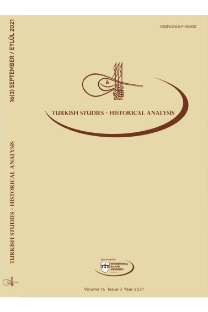Sina Dağı Arşivinde Osmanlı İzleri: Fermanlar ve İmtiyazlar
Ottoman Traces in the Archive of Mount Sinai: Fermans and Concessions
___
- Belge, H. (2018). 19. Yüzyıl Osmanlı Taşra İdaresinde Aynaroz Manastırları. Yayımlanmamış Doktora Tezi, Gazi Üniversitesi - Sosyal Bilimler Enstitüsü.
- Belge, H., Reyhan, C. (2018). “Osmanlı Taşra İdaresinde Adem-i Merkeziyet Sorunu: Aynaroz Örneği.”, OTAM, (44): 221-253.
- Bozkurt, G. (1987). “İslam Hukukunda Zimmilerin Hukuki Statüleri”. Dokuz Eylül Üniversitesi Hukuk Fakültesi Dergisi (Prof. Dr. Kudret Ayiter Armağanı) , III, (1-4).
- Clark, K. (1952). Checklist of Manuscripts ın St. Catherine’s Monastery, Mount Sinai (Ed. Kenneth W. Clark), Library of Congress.
- Speake, G. (2011). Mount Athos: Microcosm Of The Christian East, (Eds. G. Speake, K. Ware), Peter Lang.
- Acun, F. (2002). Osmanlı İmparatorluğu’ndan Gayri Müslim Din Adamlarına Verilen İmtiyazlar: 16. Yüzyılda Tur-ı Sina Manastırı. XIV. Türk Tarih Kongresi, 9-13 Eylül 2002 Ankara, Cilt II, II. Kısım, (Kongre bildirileri 2005’te yayımlanmıştır): 1403-1411.
- Arundale, F.(1837). Illustrations of Jerusalem and Mount Sinai: Including the Most Interesting Sites Between Grand Cairo, Henry Colborn Publisher.
- Atiya, A. (1952). “The Monastery of St. Catherine and the Mount Sinai Expedition”, Proceedings of the American Philosophical Society, 96 (5): 578-586.
- Curzon, R. (1849). Visits To Monataries In Levant, The Library Of University Of California.
- Çolak, H. (2012). “Relations Between The Ottoman Central Administration and the Greek Orthodox Patriarchates of Antioch, Jerusalem and Alexandria: 16th -18th Centuries”, Unpublished PhD Thesis, The University of Birmingham.
- Forsyth, G. (1968). “The Monastery of St. Catherine at Mount Sinai: The Church and Fortress of Justinian”, Dumbarton Oaks Papers, (22): 1-19.
- Gürkan, S. L. (2003). “Manastır”, İslam Ansiklopedisi, C. 27, Türk Diyanet Vakfı Yayınları, 558- 560.
- Hobbs, J. (1995). Mount Sinai, University of Texas Press.
- Isaksson, B. (1997). “The Monastery of St. Catherine and the New Find”, Built on Solid Rock Studies in Honour of Professor Ebbe Egede Knudsen on the Occasion of his 65th Birthday April llth 1997, (Ed. Elie Wardini), Instituttet for sammenlignende kulturforskning.
- Litsas, K. E. (1987). “The Mount Athos Manuscripts And Their Cataloguing”, The Knowledge Bank At The Ohio State University, (17-18): 106-118.
- Ševčenko, I. (1966) “The Early Period of the Sinai Monastery in the Light of Its Inscriptions”, Dumbarton Oaks Papers, (20): 255-64.
- Ševčenko, N. (2006). “The Monastery of Mount Sinai and the Cult of Saint Catherine”. In Byzantium, Faith and Power (1261-1557): Perspectives on Late Byzantine Art and Culture, (Ed. Sarah T. Brooks), Metropolitan Museum of Art; New Haven, CT: Yale University Press,118-137.
- Ševčenko, N. (2010). “Manuscript Production on Mount Sinai from the Tenth to the Thirteenth Century”, Approaching the Holy Mountain: Art and Liturgy at St. Catherine’s Monastery in the Sinai (Eds. Sharon E. J. Gerstel and Robert S. Nelson), Turnout, Belgium: 233-258.
- Schwartz, J. (2010). “Sinai Mountain and Desert The Desert Geography and Theology of the Rabbis and Desert Fathers”, Eisenbrauns: 353-372.
- Sinanoğlu, M. (2009). “Sina”, İslam Ansiklopedisi, Cilt 37, Türk Diyanet Vakfı Yayınları: 221-222.
- Talbot, A. - M. (1999). “Bizans Manastır Sistemine Giriş (Çev. Ö. Arıkan).”, Cogito, (17):161-178.
- Türkiye Cumhuriyeti, Devlet Arşivleri Başkanlığı, Osmanlı Arşivi (BOA)
- BOA.A.DVNSMHM.d.101/224
- BOA.C.ADL. 98/5887
- BOA.C.ADL.2/125
- BOA.C.ADL.48/2877
- BOA.C.ADL.93/5540
- BOA.DH.MKT.1094/61
- BOA.DH.MKT.482/23
- BOA.HR.HMŞ.İŞO.89/6
- BOA.HR.MKT. 294/19
- BOA.HR.MKT.109/55
- BOA.HR.MKT.200/25
- BOA.HR.MKT.311/17
- BOA.HR.TH.111/41
- BOA.İE.MİT.1/3
- BOA.Y.EE.24/67
- Library of Congress Dijital Koleksiyonu
- https://www.loc.gov/resource/amedmonastery.00279388999-ms/?sp=6&r=- 1.046,0.018,3.093,1.268,0
- Library of Congress, Mikrofilm: 172
- Library of Congress, Mikrofilm: 194
- Library of Congress, Mikrofilm: 198
- Library of Congress, Mikrofilm: 348
- ISSN: 2667-5552
- Yayın Aralığı: Yılda 4 Sayı
- Başlangıç: 2006
- Yayıncı: ASOS Eğitim Bilişim Danışmanlık Otomasyon Yayıncılık Reklam Sanayi ve Ticaret LTD ŞTİ
Mondros Mütarekesi’nin Hemen Öncesinde Karesi Sancağı’nda Firariler Sorunu ve Eşkıyalık Faaliyetleri
Türk Silahlı Kuvvetlerinde İktidar Mücadelesi ve Siyasete Etkisi (27 Mayıs 1960-20 Kasım 1961)
1946 ile 1950 Genel Seçimleri Arasında Kırklareli’de Siyasi Durum
Sayyad-ı Bahri Kalyonu Üzerinden Ticaret Kalyonlarını Okumak
Türkiye Selçukluları Zamanında Kervansarayların Kale ve Savunma Yapısı Olarak Kullanılması
Osmanlı Dönemi Ilıca Kazası Mezar Taşları Üzerine Bir İnceleme
İlker Mümin ÇAĞLAR, Arzu TAŞCAN, Hasancan ERALACA
Sina Dağı Arşivinde Osmanlı İzleri: Fermanlar ve İmtiyazlar
1935 Yılı Dış Politika Raporları Doğrultusunda Türkiye’nin Uluslararası Gelişmelere Bakışı
İlhanlı Sivil ve Askeri Teşkilatında Uygur Türkleri ve Anadolu’da Uygur Mirası Üzerine
